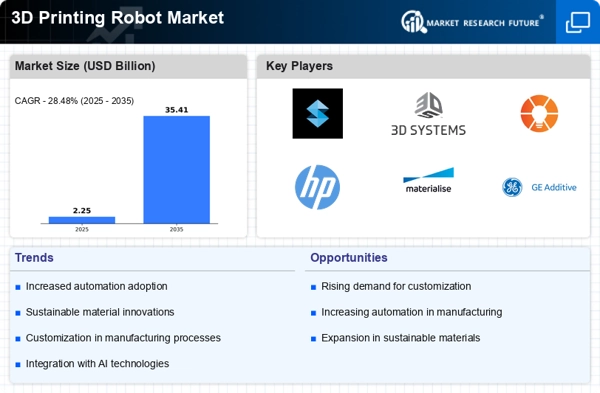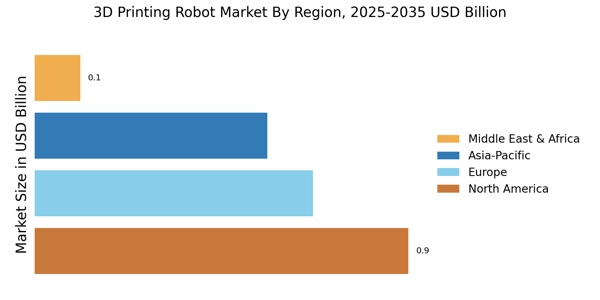Advancements in Material Science
Innovations in material science are playing a pivotal role in shaping the 3D Printing Robot Market. The development of new materials, such as advanced polymers and metal alloys, is expanding the capabilities of 3D printing technologies. These materials not only enhance the mechanical properties of printed objects but also allow for greater customization and functionality. For instance, the introduction of biocompatible materials is revolutionizing the healthcare sector, enabling the production of personalized medical devices and implants. Market data suggests that the materials segment is expected to witness significant growth, as manufacturers increasingly seek to leverage these advancements to meet diverse application needs. Consequently, the evolution of material science is likely to be a key driver in the ongoing expansion of the 3D Printing Robot Market.
Rising Demand for Prototyping Solutions
The 3D Printing Robot Market is experiencing a surge in demand for rapid prototyping solutions across various sectors. Industries such as automotive, aerospace, and healthcare are increasingly adopting 3D printing technologies to accelerate product development cycles. This trend is driven by the need for faster time-to-market and the ability to create complex geometries that traditional manufacturing methods cannot achieve. According to recent data, the prototyping segment is projected to account for a substantial share of the market, indicating a shift towards more innovative design processes. As companies seek to enhance their competitive edge, the integration of 3D printing robots into their workflows appears to be a strategic move, further propelling the growth of the 3D Printing Robot Market.
Emergence of Smart Manufacturing Practices
The emergence of smart manufacturing practices is significantly influencing the 3D Printing Robot Market. As industries adopt Industry 4.0 principles, the integration of 3D printing robots into smart factories is becoming more prevalent. These robots are equipped with advanced sensors and connectivity features, enabling real-time monitoring and data analysis. This shift towards automation and data-driven decision-making is enhancing production efficiency and reducing operational costs. Market forecasts suggest that the adoption of smart manufacturing technologies will continue to rise, further driving the demand for 3D printing robots. As manufacturers seek to optimize their processes and improve product quality, the alignment of 3D printing technologies with smart manufacturing initiatives is likely to be a key factor in the growth trajectory of the 3D Printing Robot Market.
Growing Adoption in Education and Training
The 3D Printing Robot Market is witnessing a growing adoption of 3D printing technologies in educational institutions and training programs. As educators recognize the value of hands-on learning experiences, 3D printing is being integrated into curricula to teach students about design, engineering, and manufacturing processes. This trend is fostering a new generation of skilled professionals who are well-versed in advanced manufacturing techniques. Market analysis indicates that educational institutions are increasingly investing in 3D printing technologies, which not only enhances learning outcomes but also prepares students for careers in industries that rely on these technologies. The emphasis on education and training is likely to contribute to the long-term growth of the 3D Printing Robot Market, as it cultivates a workforce equipped to drive future innovations.
Increased Investment in Research and Development
Investment in research and development is a critical driver for the 3D Printing Robot Market. Companies are allocating substantial resources to explore new applications and improve existing technologies. This focus on R&D is essential for fostering innovation and enhancing the performance of 3D printing robots. As organizations strive to stay ahead of the competition, they are likely to invest in developing more efficient and versatile printing systems. Recent statistics indicate that R&D spending in the 3D printing sector has seen a notable increase, reflecting the industry's commitment to advancing its technological capabilities. This trend suggests that the 3D Printing Robot Market will continue to evolve, driven by the pursuit of cutting-edge solutions and enhanced operational efficiencies.

















Leave a Comment